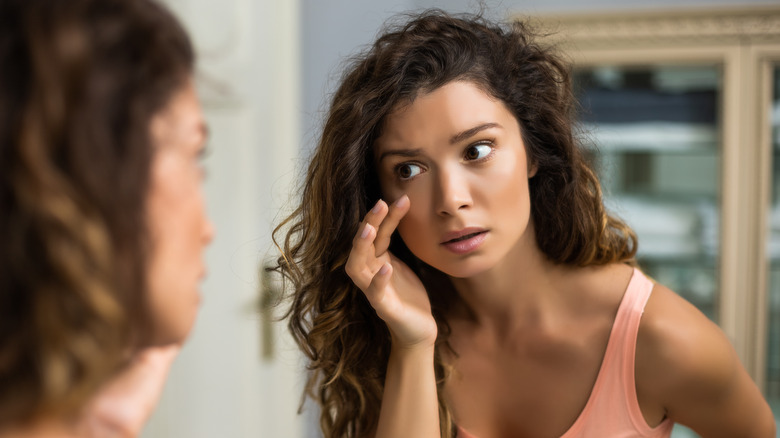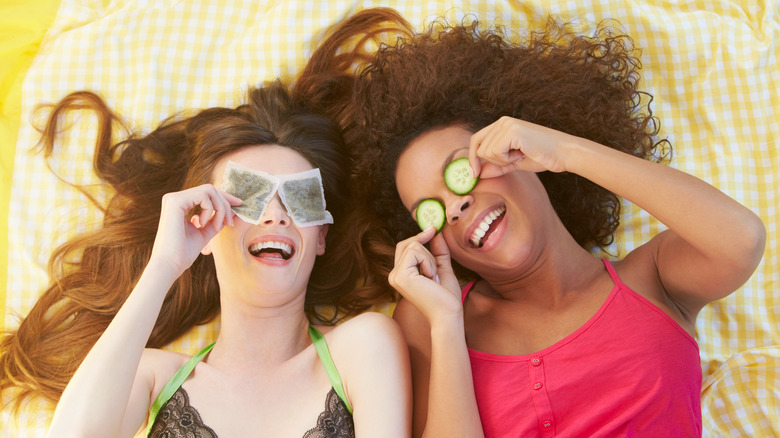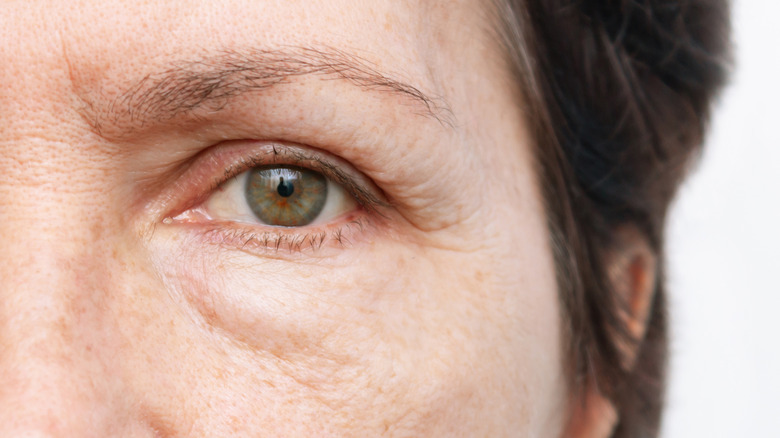The Easiest Ways To Diminish Undereye Bags
We may receive a commission on purchases made from links.
For some people, eye bags are genetic. For others, they're caused by a medical condition and often made worse by allergies. If the latter is the case, then the very best thing you can do is visit your doctor to get the very best tailored medical advice. But genetics are not the only reasons under eye bags can develop over time; a high-salt diet (and similarly, dehydration), for instance, could also be to blame, or it could just be a natural part of getting older. "The most common cause of under-eye bags or puffiness is natural aging. Older skin becomes too lax and tends to fall or wrinkle. The muscles and tissues around the eye can also weaken and contribute to the baggy look," Dr. Shaun Desai, a facial plastic and reconstructive surgeon, told Johns Hopkins Medicine. "This weakening allows the fat surrounding the eye to bulge out, creating that bubble-like appearance."
It's worth nothing that under eye bags and puffy eyes are two different things. The medical term for under eye bags is lower eyelid fat prolapse, whereas the medical term for puffy eyes is periorbital edema. Puffy eyes are usually more easily diminished, whereas under eye bags may last longer or even be permanent. But no matter what's causing your puffy eyes or under eye bags, there are things you can try to help tone them down.
Try changing up your diet
Although drinking more water won't magically make your eye bags vanish, experts say that making sure you're always hydrated can prevent them from getting worse. "Maintaining proper hydration enhances circulation, which helps remove excess fluid from the eye area," Dr. Chaneve Jeanniton, a board-certified oculofacial plastic surgeon, explained to Vogue. The National Heart Lung and Blood Institute recommends drinking between six and twelve cups per day. While you're at it, it can't hurt to lower your sodium intake. The World Health Organization recommends limiting your intake to below 2,000 milligrams of sodium (that's less than 5g per day of salt) per day.
Another way to minimize visible under eye puffing? Try eating more foods containing vitamin C. Doing so could help your body to absorb more hyaluronic acid and therefore help with collagen production. This could help minimize sagging under the eyes, which could in turn make bags look less obvious.
Use a cold compress for temporary relief
If you're only dealing with temporary puffiness and looking for an easy and quick fix, a cold compress can do wonders. Placing something chilly on the undereye helps to reduce the blood flow to the area, in turn, decreasing the appearance of inflammation. What you use is up to you, but something as simple as a chilled spoon, ice pack or slice of cucumber can help.
Another thing you could place over the eyes? Tea bags! According to John Hopkins Medicine, the caffeine in the tea helps to help combat a puffy appearance. As certified clinical and research dermatologist Dr. Jeannette Graf told Dermstore, "Caffeine is soothing, anti-inflammatory and vasoconstrictive, which can decrease redness and puffiness." A 2020 research review found that green tea bags in particular can really help with under eye puffiness due to its high anti-inflammatory properties. That explains why eye creams containing caffeine or tea extracts are often well reviewed.
It's worth noting, however, that a cold compress of any kind is likely to only be a temporary fix to any under eye issues. "There are many non-surgical treatments that can help reduce the appearance of under-eye bags and dark circles, although they are not permanent solutions," dermatologist Dr. Michele Green admitted to Vogue.
Certain cosmetic treatments can help
If you are dealing with more deep set eye bags, there are some professional treatments that can help. Dermal fillers are one popular choice that work by injecting sagging skin with hyaluronic acid or poly-l-lactic acid, which plumps the skin and immediately creates smoother appearance. Another popular option are laser resurfacing treatments, which work by naturally by increasing cell turnover and stimulating collagen production in the area. Both treatments are shown to be effective at minimizing the visible appearance of wrinkles in the eye area, though what you choose ultimately depends on how you want to go about treatments and cost. If you'd rather avoid lasers and needles, a chemical peel can also help with managing wrinkled skin, though the result may not be as long-lasting or dramatic as other methods.
Of course, you're looking for a more dramatic and permanent results, you could go the surgical route. A lower eyelid lift (also known as a blepharoplasty), can also help to eliminate under eye bags by tightening the muscle and the skin under the eye. There are also other types of eyelid surgery available which involve removing some of the skin and reshaping it around the eye. Of course, any surgery like this though is a serious commitment and requires a lot of research before going under the knife.
Figure out exactly what's causing your undereye issues
Although aging is often to blame for under eye bags, there can be a wide range of other medical conditions that contribute to the issue. Those can include the likes of thyroid eye disease, chronic kidney disease, or conjunctivitis. Heading to the doctor and finding out exactly what's behind the issue will not only help you stay healthy and treat any underlying health problems, but it will also allow you to get specific treatment without accidentally making the issue worse or wasting time on at-home remedies that won't make a difference.
It's not just more serious medical conditions that can affect the undereyes, though. Allergies can also be behind the puffing. "A lot of people have allergies and don't even realize it. Even without having the itchiness that comes with allergies, or if you're using contacts, it can sometimes irritate the eyes and cause fluid to build up under the eyes, creating the appearance of puffiness," Dr. Natasha Sandy, a board-certified physician with specialist training in dermatology, explained to Vogue.




